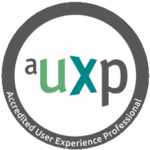Welcome to the
International Accreditation Program for UX Professionals
The International Accreditation Board for UX Professionals hosts a program, that provides a listing in a register of UX professionals, after a due review of work history and professionalism. This listing represents an unbiased acknowledgement of people that work within the wide field of UX & Usability, it shows the shared understanding of professional work, the strife for quality and a human-centered mindset, regardless of your field of work, your job role, or your pay grade. An accredited UX professional communicates its will to be scrutinized by a body of evaluation, one’s work to be questioned, be willing to let others speak one one’s behalf and to adhere to the code of conduct of UX professionals.
Overview of the International Accreditation Program for UX Professionals
The accreditation of UX professionals follows 5 steps that are designed to understand your professional background, your work and your understanding of work in the field of UX, human-centered design and Usability. To focus the accreditation process, and also bearing in mind that no one can be good at everything, you are able to choose up to 3 focus areas of your expertise that will be subject for accreditation. If you feel the strong desire to list a fourth focus area, an additional accreditation process would be necessary (this additional accreditation program is in preparation). All submissions, documents, recommendations and references must be in German or English or with an adequate translation. Other languages will follow.
A peer review as the core of the program
After checking the first steps, the applicants receive feedback about any missing or incorrect submissions. This gives applicants the opportunity to improve or add this information. If all the information is correct and sufficient for the last step, the accreditation body arranges a 10-minute video call, in which two to three terms from the field of human-centered design are then discussed with the applicant.
After successfully completing all 5 steps, the UX professional receives an accreditation number and is accepted into the professional register. He/she then has the right to use the designation “Accredited UX Professional” with the accreditation number.
Cost for accreditation: 350 Euro / Dollar
Cost for UXPA Members (International or Chapters) or Members of participating organizations: 300 Euro / Dollar
[Nov. 2022]
- UX Strategy
focuses on establishing human-centric principles in strategic activities within an organization and aligning business goals with UX strategy. - UX Management
deals with the human-centered design activities within a project and is the counterpart to traditional project management / product owner (PM / PO). If PM has to represent business requirements, UXM maximizes the benefit for the specific user and minimizes project costs through pragmatic and technically flawless application of the principles of human-centered design. - UX / User Research
focuses on the collection, investigation and analysis of behavior, needs, motivations and frustrations of potential future users using scientific methods. Based on these findings, valid design decisions can be made, thus reducing project risks. - User Requirements
ensures that the user requirements identified in the research are reconciled with the requirements of the stakeholders and the company and are passed on to the product, service, process and system development in a verifiable manner. - Information Design
deals with the creation of task-appropriate information for interactive systems or with the adaptation of existing content for them. Depending on the context of use, different media and their combinations can be used for this purpose. For example, designed presentations of processes, information graphics, animations, technical documentation etc., supporting the user in performing the tasks and may represent essential components of the system. - Interaction Design
specifies the interactions between users and the interactive system, describes the process flow by elements that are necessary for the interaction. Learned or unconscious processes and intercultural deviations must be considered. The focus is on the interaction of a human with a system within tasks and not on the visual appearance. - Information Architecture
deals with the organization, structuring and labeling of content in an effective and sustainable manner. This role supports users in finding information, making decisions and completing tasks. It must keep an overview of all subsystems in order to make all information available to users at the right time in a manner that supports the suitability for the task. - UX Writing
develops the texts for the user interface with other stakeholders in order to support users in completing their tasks as efficiently and effectively as possible. Particular value is placed on the different user groups and accessibility, and the choice of language style contributes to recognition. - Interface Design
is responsible for the visual and/or physical appearance, with interpretation of the corporate design guidelines, taking into account interaction specifications. Even if usability has priority, the user interface design serves the requirement of attractiveness by means of typography, colors, form, material, production technique, symbolic and visual language and the Gestalt laws. Consistency is created through the stringent design of interaction elements and transferred to sustainable design systems. - UI Development
is responsible for the accurate, stable and efficient translation of the specifications and designs into a technical solution. In addition, these roles ensure the functioning of this solution over the entire life cycle of the same. As a partner of the usability and UX roles described above, it completes the holistic claim of interdisciplinary work in human-centered design. - Testing / Evaluation
regularly validates usability and provides objective evidence that the specified requirements for a specific use or application have been met by an interactive system for specific users - Accessibility
provide broad expertise in accessibility and design for all across the organization and solution development. They can provide technical recommendations as well as inform strategic planning and other implementation roles about accessibility. - Academic Education & Research
being active in academic, school or other non-commercial organizations in education and training in the field of human-centered design, usability, as well as research roles in the field.
What kind of education did you have? In which area or academic field did you graduate? What training did you get? Regardless of university, college, school or vocational training – select the field of your last diploma. This list consists of typical areas that are considered to relate scientifically to human-centered design and UX/Usability. If your area of education is not listed, just notify us about that area. For proof, upload a copy of your diploma.
Depending on your area of education, you will have to show 5 or 8 years of professional work experience in the field of UX/Usability. This, you can exhibit with work contracts, certificate of employments, invoices, business licence, order by clients or similar. Upload up to 3 proofs that cover the required time span.
What do others think about you and your work? How is your work rated by others? To answer these questions, please download this template and have 3 people from your professional environment fill it out. Then upload the completed forms. However, if you have received a certificate from a recognized, multi-day certification process (e.g. UXQCC, UXQB, Fraunhofer FIT) as part of a training program, you can replace one recommendation with a certificate. Important: Please only use the ready-made template for recommendations. Other submissions will not be accepted.
Now we want to know more about your work. Upload 3 work references that correspond to the desired focus fields in which you would like to be accredited (please avoid or explain any abbrevations used). It should be noted that the following additional information must be given for each individual work reference:
- Project reference
- Context of use with user groups
- Problem definition and requirements
- Objective of the applicant’s task
- Solution (Artifacts and/or Deliverables)
- Justification of the derived (design) decisions
- Final result (possibly link to completed project)
- Personal reflection on the project
- Study project, study initiative, strategic initiative, management initiative
- Objective of the initiative
- General conditions and requirements
- Objective of the applicant’s task
- Solution (Artifacts and/or Deliverables)
- Justification of the derived decisions
- Final result (possibly link to completed project)
- Personal reflection on the project
Instead of one work reference, the applicant can also submit two publications in independent media (books, journals, conference publications or public lectures).
To ensure a common understanding of the core concepts, terms, and definitions in the field of UX/Usability, a 10-minute video call will be scheduled with you. In this call, two accreditors will discuss two to three of the terms listed below. Basis of the discussion is the understanding of these terms as described in the ISO 9241 series “Ergonomics of human-system interaction”.
- Accessibility
- Context of Use
- Effectivity
- Efficiency
- Human-centered Design
- Satisfaction
- Task
- Usability
- User
- User Experience
- User Need
- User Requirement
- Verification
- Validation/Evaluation


